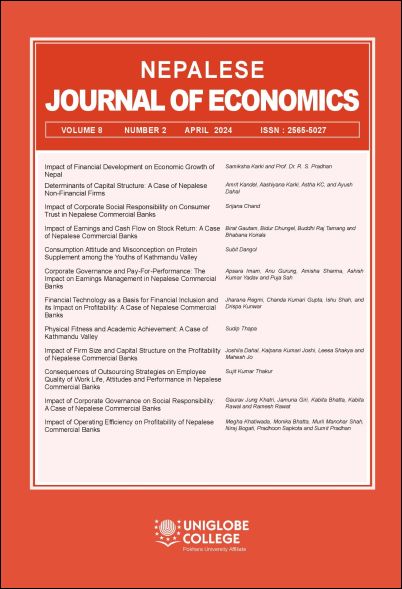Determinants of Capital Structure: A Case of Nepalese Non-Financial Firms
DOI:
https://doi.org/10.3126/nje.v8i2.68802Keywords:
assets tangibility, liquidity, non-debt tax shields, firm size, profitability, Tobin's q, firm's age, short term debt ratio, long term debt ratioAbstract
This study examines the determinants of capital structure in the context of Nepalese non-financial firms. Short term debt ratio and long term debt ratio are selected as the dependent variables. The selected independent variables are assets tangibility, liquidity, non-debt tax shields, firm size, profitability, Tobin’s q and firm’s age. The study is based on secondary data with 105 observations from 7 hydro power firms, 3 hotel industries and 4 manufacturing firms listed in Nepal Stock Exchange (NEPSE). The data were collected from annual reports of the selected non-financial firms. The correlation coefficients and regression models are estimated to test the significance and importance of determinants of capital structure in the context of Nepalese non-financial firms.
The study showed that assets tangibility has a positive impact on long-term debt ratio and short-term debt ratio. It indicates that higher the assets tangibility, higher would be the long-term debt ratio and short-term debt ratio. Similarly, liquidity has a positive impact on long-term debt ratio and short-term debt ratio. It indicates that increase in liquidity leads to increase in long-term debt ratio and short-term debt ratio. Likewise, non-debt tax shields has a positive impact on long-term debt ratio and short-term debt ratio. It indicates that increase in non-debt tax shields leads to increase in long-term debt ratio and short-term debt ratio. Further, firm size has a positive impact on long-term debt ratio and short-term debt ratio. It indicates that increase in firm size leads to increase in long-term debt ratio and short-term debt ratio. In addition, profitability has a positive impact on long-term debt ratio and short-term debt ratio. It indicates that increase in profitability leads to increase in long-term debt ratio and short-term debt ratio. Likewise, Tobin’s q has a positive impact on long-term debt ratio and short-term debt ratio. It indicates that higher the Tobin’s q, higher would be the long-term debt ratio and short-term debt ratio. Moreover, firm’s age has a negative impact on long-term debt ratio and short-term debt ratio. It indicates that higher the firm’s age, higher would be the long-term debt ratio and short-term debt ratio.




